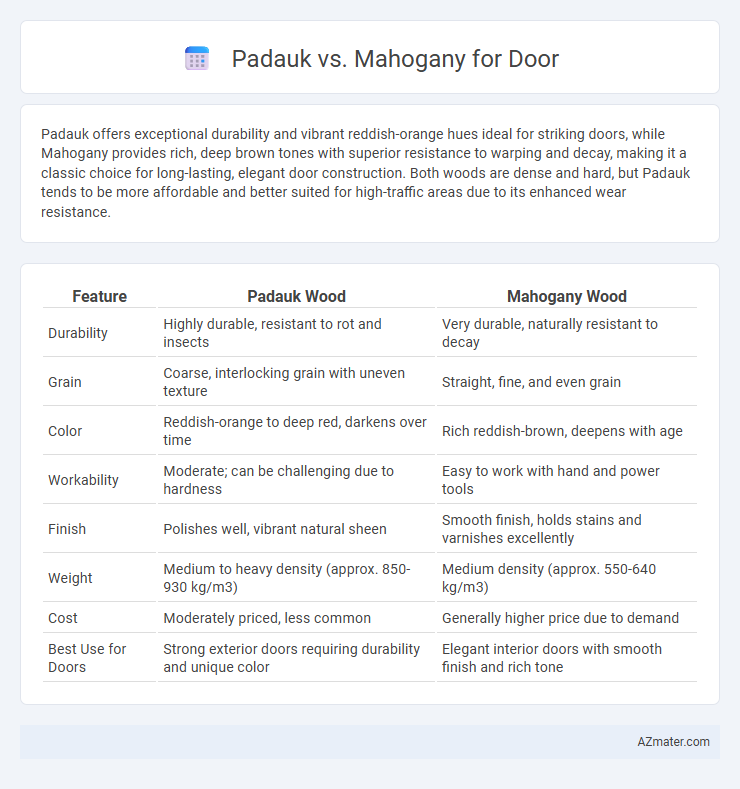Padauk offers exceptional durability and vibrant reddish-orange hues ideal for striking doors, while Mahogany provides rich, deep brown tones with superior resistance to warping and decay, making it a classic choice for long-lasting, elegant door construction. Both woods are dense and hard, but Padauk tends to be more affordable and better suited for high-traffic areas due to its enhanced wear resistance.
Table of Comparison
| Feature | Padauk Wood | Mahogany Wood |
|---|---|---|
| Durability | Highly durable, resistant to rot and insects | Very durable, naturally resistant to decay |
| Grain | Coarse, interlocking grain with uneven texture | Straight, fine, and even grain |
| Color | Reddish-orange to deep red, darkens over time | Rich reddish-brown, deepens with age |
| Workability | Moderate; can be challenging due to hardness | Easy to work with hand and power tools |
| Finish | Polishes well, vibrant natural sheen | Smooth finish, holds stains and varnishes excellently |
| Weight | Medium to heavy density (approx. 850-930 kg/m3) | Medium density (approx. 550-640 kg/m3) |
| Cost | Moderately priced, less common | Generally higher price due to demand |
| Best Use for Doors | Strong exterior doors requiring durability and unique color | Elegant interior doors with smooth finish and rich tone |
Introduction to Padauk and Mahogany
Padauk and mahogany are premium hardwoods commonly used in door construction due to their durability and aesthetic appeal. Padauk, known for its vibrant reddish-orange color and fine texture, offers excellent resistance to decay and insect attacks, making it ideal for exterior doors. Mahogany features a rich, deep brown hue with a straight grain pattern, prized for its strength, stability, and luxurious finish in both interior and exterior door applications.
Origin and Source of Padauk and Mahogany
Padauk is primarily sourced from tropical regions of Africa and Southeast Asia, including countries like Myanmar, Cambodia, and India, while Mahogany originates mainly from Central and South America, especially countries such as Honduras, Brazil, and Cuba. The African Padauk is known for its rich reddish-orange color and durability, whereas American Mahogany is prized for its deep reddish-brown hue and fine grain. These distinct origins contribute to differences in wood density, weather resistance, and suitability for door manufacturing.
Appearance and Grain Comparison
Padauk features a vibrant reddish-orange hue that darkens to a deep reddish-brown over time, providing a striking and bold appearance for doors, while mahogany offers a rich, warm reddish-brown tone with subtle golden highlights that ages gracefully. The grain of Padauk is typically straight with occasional interlocking patterns, giving a pronounced, coarse texture that enhances its visual character, whereas mahogany exhibits a fine, even grain with a smooth texture, contributing to a more refined and elegant door finish. Choosing between Padauk and mahogany depends on the desired aesthetic impact, with Padauk delivering vivid contrast and boldness, and mahogany presenting timeless sophistication and uniformity.
Durability and Hardness Differences
Padauk offers exceptional durability with a Janka hardness rating of approximately 1720, making it highly resistant to dents and scratches for door use. Mahogany, with a Janka hardness around 800 to 900, is comparatively softer but provides excellent stability and resistance to decay. The superior hardness of Padauk ensures longer-lasting doors under heavy use, while Mahogany's moderate hardness still delivers reliable durability combined with rich aesthetics.
Workability and Machinability
Padauk offers excellent workability with its fine grain and moderate density, making it easy to shape and carve for detailed door designs. Mahogany also excels in machinability, featuring a straight grain and uniform texture that allow smooth cutting, sanding, and finishing processes. Both woods are favored for door construction due to their ease of handling with hand and power tools, but Padauk's slightly denser structure may require sharper blades for precision work.
Weather Resistance and Outdoor Use
Padauk offers superior weather resistance compared to Mahogany, making it an excellent choice for outdoor doors exposed to varying climates. Its natural oils and dense grain structure provide exceptional durability against moisture, UV rays, and insect damage. Mahogany, while durable and aesthetically pleasing, requires regular maintenance and protective finishes to withstand prolonged outdoor exposure effectively.
Cost and Availability
Padauk doors generally cost less than mahogany due to their faster growth rate and wider availability, making them a budget-friendly option for quality hardwood doors. Mahogany, prized for its durability and rich color, tends to be more expensive and less readily available because of slower growth and stricter logging regulations. Both woods offer sturdiness, but Padauk's cost-effectiveness and accessibility make it a popular choice in regions with abundant tropical timber resources.
Maintenance and Longevity
Padauk offers exceptional durability and resistance against insects and decay, making it a low-maintenance choice for doors with longevity extending over several decades. Mahogany requires periodic sealing and polishing to preserve its rich color and prevent moisture damage, but it also boasts impressive lifespan with proper care. Both woods provide robust structural integrity, though Padauk tends to maintain its vibrant orange-red hue longer without frequent refinishing.
Sustainability and Environmental Impact
Padauk wood offers a sustainable choice for doors due to its fast growth rate and availability from responsibly managed plantations, reducing deforestation pressures. Mahogany, particularly genuine or Honduran varieties, faces sustainability challenges because of slower growth and overharvesting in native forests, impacting biodiversity and carbon storage. Selecting certified Padauk helps minimize environmental impact by supporting sustainable forestry practices and lowering ecological footprints compared to conventional mahogany harvesting.
Conclusion: Choosing the Right Wood for Your Door
Padauk offers a vibrant reddish-orange hue and exceptional durability, making it ideal for doors requiring a bold, long-lasting appearance. Mahogany, known for its rich, deep color and fine grain, provides timeless elegance and excellent resistance to warping and decay. Selecting between Padauk and Mahogany depends on the desired aesthetic and environmental resilience, with Padauk suited for striking architectural statements and Mahogany preferred for classic, enduring door designs.

Infographic: Padauk vs Mahogany for Door
 azmater.com
azmater.com